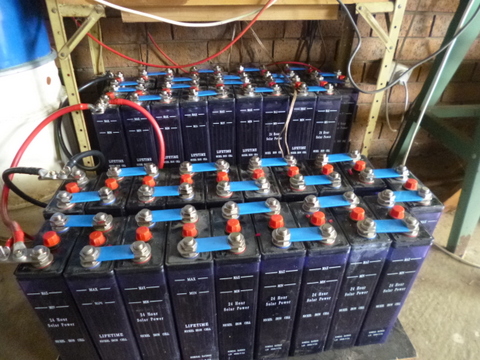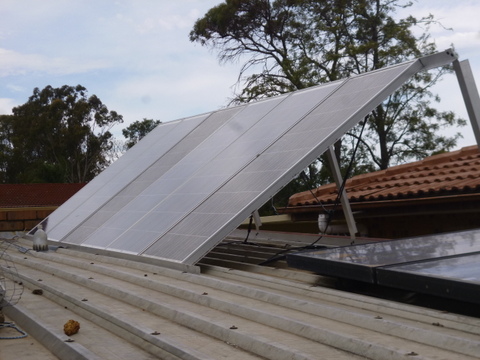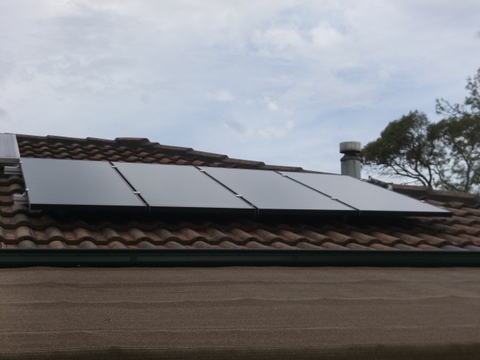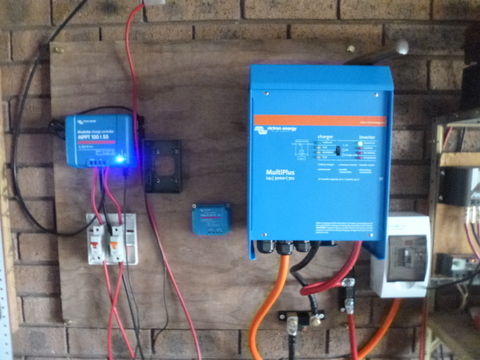Introduction
We have had a 12 volt system providing house lighting for over 35 years, a 12 volt fridge powered off a separate bank for close to 10 years and we have also had a grid connected 1kW photovoltaic array on the 60c feed-in tariff for 6 years or more. However, with one battery bank at the end of its projected life, the other showing signs of failure and with the ending of the 60c feed in tariff at the end of this year it was time for a re-evaluation of what we had.
Electricity Usage
Over the years we have worked hard to reduce electricity consumption to the point now where our electricity bills are telling us we consume between 4 and 6 kW hours per day for a two person household. Anyone thinking of going off grid should first conduct an energy audit and get hold of an energy meter (as we did) and then work at bringing their electricity consumption down as far as they can. This will reduce the overall cost of the system you put in and ensure that the system is sized appropriately for your needs.
There are other factors to consider too, and to size our system so that we could still operate but it would not cost the national debt to install, we had to make some decisions. After much to-ing and fro-ing we decided to do the following –
- We would design the system so that several large, but rarely used loads would still draw from the grid, but all of our power points and the few lights still using 240v would draw from the new off grid system. These grid connected loads consisted of –
- the electric boost for our solar hot water heater (used 3 times last winter),
- the air con, (used a half a dozen times a summer to keep Linda from melting on those hot western Sydney summer afternoons), and
- a 15 amp socket in the garage, used to power my electric welder, which I have used approximately 3 times in the last 5 years.
- We would leave the current 1 kW back to the grid system in place, even though we would receive considerably reduced compensation for the electricity we put back into the grid. The idea being that it would work towards covering us for when we used the above mentioned high consumption but low usage loads.
Batteries
The lighting bank of 4 x 6 volt deep cycle lead acid batteries are 10 years old and while they are still working well and retaining a charge, they are nearing the end of their projected service life. They have been integrated into the new system, for the moment at least. The low maintence deep cycle 12 volt battery bank which powers the fridge have had one battery fail in service already and from their current performance it was likely that others were heading the same way. The entire bank (4 batteries) were decommissioned and recycled.
The new (2) battery banks are each composed of 19 x 1.2 volt 100 amp hour brand new nickel iron batteries. The batteries in each bank are connected in series to provide 24 volts and then the two banks are connected in parallel to double our storage capacity.
Power Generation
We had the following panels arrayed around the place, mostly on the roof of the garage.
Connected to the battery bank powering the house lights –
1 x Solarex panel, Specs: X44 BG 1.35 amps (nom 12 volt)
1 x BP solar panel, Specs: 2.5 amps (nom 12 volt)
1 x Photowatt panel PW 750 Specs: 4.4 amps 75 watts 21 volts
1 x Solarex panel no specs 76.4cm x 50.2 cm
2 x sharp panels, Specs: 130w 22v 8.09 amps
Connected to the battery bank powering the fridge were -
4 x Solarex panels, Specs: 83 watts 21.4 volts 5.31 amps
Our Airex 400w wind generator was also connected to the fridge battery bank
And sitting in the garage not connected to anything were -
4 x SolarE panels, Specs: 130w 17.3v 7.51 amps
Following the review and upgrade of our system, the two Solarex panels from the lighting power system, the BP solar panel and the Photowatt panel have been decommissioned and are waiting for me to work out what on earth I am going to do with them. My mate who is the solar guru says they should be donated to a museum of some description. (harrumph!)
The two Sharp panels and the four SolarE panels from inside the garage are now installed on the garage roof, have been connected into the system and are performing well. The bank of 4 Solarex panels which were used to power the fridge battery bank are yet to be incorporated into the system. I am having technical difficulties with them and don’t seem to be able to get any power out of them at all. They are awaiting technical assistance from my solar guru.
I have also bought and had installed 4 x Stion 140watt thin film panels which are installed on the roof at the back of the house below the back-to-the-grid ones. So far our maximum charging rate on the off grid system is over 1200 watts.
The wind generator has been reconnected to the bank of lead acid batteries currently powering the lights.
Electronics
WE have installed sufficient electronics to allow the system to work and allow me to monitor it. We have –
1 x 240volt grid changeover switch
1 x Victron 50 amp MPPT (maximum power point tracking) charge controller, which controls what the solar panels put into the batteries to get the best out of both. The MPPT has a blue tooth connection which allows me to monitor the system.
1 x Victron 3 kW inverter charger which takes the power from the batteries (24v DC) and turns it into 240v AC so that the appliances in the house can use it.
1 x DC to DC converter which is currently not connected but will enable me to deal more effectively with the 12 volt lights and 12 volt fridge.
There is also some other monitoring stuff not yet installed which will allow me to monitor what is going on with the system (batteries in particular) from our kitchen.
As you can see the system is still not fully installed and we are having some teething problems, but the implementation of any new system can result in challenges in the short term and once these are overcome we will be fully operational. It is exciting to be your own power company, and over the next few weeks (months?) expect to see more detailed articles on each of the subject discussed here.







